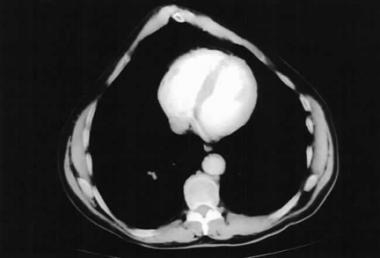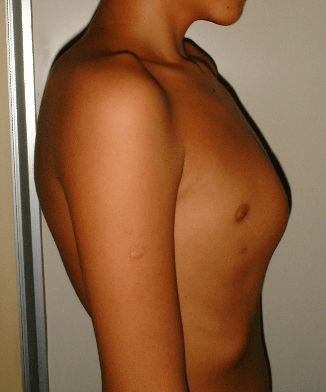What is pectus carinatum?
Pectus carinatum is a disorder where the front chest bone (called the sternum), instead of being on the same level of the chest ribs, is pushed forward so that the middle part of the chest is more evident. In this condition there might be other areas of the chest (the ribs) which are depressed or pushed inward. It is known as pigeon chest as it resemble the appearance of the chest seen in birds. In most children both sides of the chest are affected to the same extent (symmetric type) but in some other children one side if more pronounced than the other side (asymmetric type). Pectus carinatum is more common in boys and it is estimated to affect 1 in 1500 children.
What causes pectus carinatum?
The exact cause of pectus carinatum is not known but it is thought to be due to an overgrowth of the cartilages in the ribcage which grow out of proportion with the rest of the body. There seems also to be a genetic link to pectus carinatum as it can run in some families (in 25% of cases other family members are affected as well). It can be seen as a manifestation in some genetic syndromes like Marfan syndrome, Loyes-Dietz syndrome, Ehlers-Danlos syndrome, Noonan syndrome, Turner syndrome, trisomy of chromosome 21 (Down’s syndrome) or trisomy of chromosome 18 (Edward’s syndrome), homocystinuria, or osteogenesis imperfect. Pectus carinatum can also be seen in children with scoliosis.
What are the signs and symptoms of pectus carinatum?
It may not be evident in younger children but can develop over time, particularly during the growth spurt seen in adolescence. Even though the conditions can be present at birth, it is unusual before 11 years of age. Some children with pectus carinatum will have no symptoms but many will have symptoms like:
- shortness of breath, particularly during exercise
- chest pain or chest tightness
- fast heart beat at rest of with exercise
- feel tired early when compared to her peers.
The unusual shape of the ribcage can also make children not comfortable and self-conscious so that some children restrict the activities they undertake to those where they do not need to show their chest. This can have a profound impact of children development and self confidence.
Why children with pectus carinatum have symptoms?
It is thought that the chest wall of children and adolescents with this condition might be more rigid so that it might take more effort to stretch it while breathing in and breathing out. Additionally, particularly in the asymmetric type of pectus carinatum, the pull of different breathing muscles in the chest will be uneven, causing some pain on one side or the other of the chest.
What cardiac problems can be seen in children and adolescents with pectus carinatum?
Children and adolescents with pectus carinatum may have a floppy appearance of the mitral valve known as mitral valve prolapse. In this condition the mitral valve (the inlet valve to the left ventricle) may not work well and not infrequently there might be varying degrees (usually minor) of blood leakage from the mitral valve. This is usually of no clinical significance and rarely becomes a problem. A small minority of people with this condition may have significant heart problems, particularly with enlargement of the main body artery which is known as the aorta. This is more evident in children with Marfan syndrome, Loyes-Dietz syndrome or Ehlers-Danlos syndrome.
How is pectus carinatum diagnosed?
The diagnosis of pectus carinatum is made clinically by an inspection of the chest. In the more evident forms of pectus other investigations are usually required, like a computed tomography (CT) or magnetic resonance (MRI) the chest to assess in detail the appearance of the cartilage and bony structures. Children and adolescents with symptoms or more pronounced pectus carinatum will require an assessment of the heart to rule out any associated defect (see below) and will require formal assessment of their lung function to show how much is the rib cage problem affecting the breathing. If a genetic condition is suspected genetic testing might also be recommended.

How is pectus carinatum treated?
Children and adolescents with minor forms of this condition may not have any symptoms or breathing problem and may not worry about the appearance. For these children there is no need for any treatment. For those children who are still growing, a brace might represent a good option as it can help push the breastbone back into the normal position. For the bracing to work unfortunately the brace has to be worn for long periods in the day. When the problems with the ribcage are affecting the lung function or are causing symptoms or children are significantly affected by the look of the chest then surgery might be recommended. During surgery, the operator would trim and remove the abnormal cartilage and re-create the normal shape of the chest. In some cases the surgeon might need to place a metal bar at the end of the procedure to make the chest more stable and hold the repair in the right position. After 1 year the surgeon can remove the bar as it will not be required any longer.
What are the results of surgery?
Surgery produces good results. Most children and young people who receive a successful surgery grow up to lead a normal life and experience no long lasting heart or lung problems.


